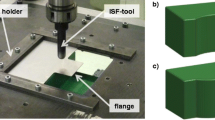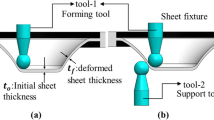Abstract
Industrial interest about Incremental Sheet Forming (ISF) process is growing in the last years. Up to a few years ago, two main investigation ways were proposed, the former aimed at analysing the process mechanics, the latter at reproducing some “case study” geometries. In industrial applications, if the long cycle-time can be neglected in small batches manufacturing, geometrical accuracy represents a relevant drawback, especially when the product has to be coupled to one another. For this reason, in the opinion of the authors, the low accuracy is the most relevant defect of ISF processes today. Among the techniques already set-up to reduce inaccuracy, the use of different material supports or the use of “arbitrarily modified” tool trajectories are probably the most known. In this paper a simple approach is proposed, based on the process self capability to correct inaccuracy when different steps of Incremental Sheet Forming are carried out on both the part surfaces. In particular, it is demonstrated that a relevant increasing in accuracy is obtainable at the second repeated step, while new ones do not reduce the inaccuracy sensitively. The above approach builds a new scenario since it allows to keep the basic equipment (without any support) and does not require any further knowledge concerning the material behaviour after the punch action. These aspects are deeply discussed in the next chapters.









Similar content being viewed by others
References
Jeswiet J, Micari F, Hirt G, Bramley A, Duflou J, Allwood J (2005) Asymmetric Single Point Incremental Forming of Sheet Metal. Ann CIRP 54/2:623–650
Bambach M, Todorova M, Hirt G (2007) Experimental and numerical analysis of forming limits in CNC Incremenal Sheet Forming. Proc Shemet Conf 511–518:2007
Jeswiet J, Hagan E (2003) Rapid proto-typing with sheet metal. CNC RFIN. Int J Form Process 6(3–4):315–324
Ambrogio G, De Napoli L, Filice L, Gagliardi F, Muzzupappa M (2005) Application of Incremental Forming process for high customised medical product manufacturing. Int J Mater Process Technol 162–163:156–162
Micari F, Ambrogio G, Filice L (2007) Shape and dimensional accuracy in Single Point Incremental Forming: state of the art and future trends. Int J Mater Process Technol 191:390–395
Dejardin S, Thibaud S, Gelin JC (2008) Finite element analysis and experimental investigations for improving precision in single point incremental sheet forming process. Int J Mater Form 1(1):121–124
Ham M, Jeswiet J (2008) Dimensional accuracy of Single Point Incremental Forming. Int J Mater Form 1(1):1171–1174
Attanasio A, Ceretti E, Giardini C, Mazzoni L (2008) Asymmetric two points Incremental Forming: improving surface quality and geometric accuracy by tool path optimization. Int J Mater Process Technol 197:59–67
Meier H, Buff B, Laurischkat R, Smukala V (2009) Increasing the part accuracy in dieless robot-based Incremental Sheet Metal Forming. CIRP Ann Manuf Technol 58/1:233–238
Rauch M, Hascoet J-Y, Hamann J-C, Plenel Y (2009) Tool path programming optimization for incremental sheet forming applications. Comput-Aided Des 41(12):877–885
Duflou JR, Callebaut B, Verbert J, De Baerdemaeker H (2008) Improved SPIF performance through dynamic local heating. Int J Mach Tools Manuf 48(5):543–549
Varady T, Martin R, Cox J (1997) Reverse engineering of geometric models—an introduction. Comput-Aided Des 29(4):255–268
Author information
Authors and Affiliations
Corresponding author
Rights and permissions
About this article
Cite this article
Ambrogio, G., Filice, L. On the use of Back-drawing Incremental Forming (BIF) to improve geometrical accuracy in sheet metal parts. Int J Mater Form 5, 269–274 (2012). https://doi.org/10.1007/s12289-011-1053-8
Received:
Accepted:
Published:
Issue Date:
DOI: https://doi.org/10.1007/s12289-011-1053-8




